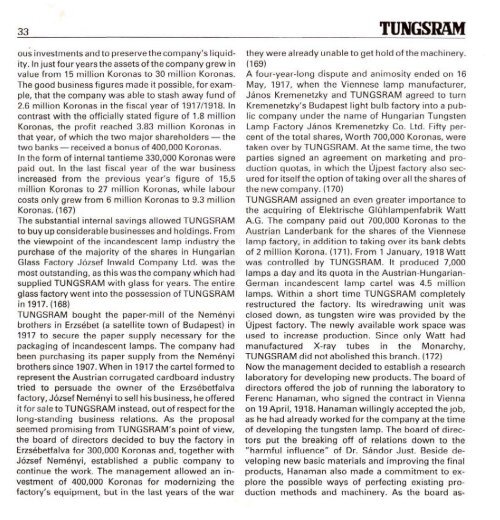THE HISTORY OF TUNGSRAM 1896-1945 - MEK
THE HISTORY OF TUNGSRAM 1896-1945 - MEK
THE HISTORY OF TUNGSRAM 1896-1945 - MEK
- No tags were found...
Create successful ePaper yourself
Turn your PDF publications into a flip-book with our unique Google optimized e-Paper software.
33 <strong>TUNGSRAM</strong>ous investments and to preserve the company's liquidity.In just four years the assets of the company grew invalue from 15 million Koronas to 30 million Koronas.The good business figures made it possible, for example,that the company was able to stash away fund of2.6 million Koronas in the fiscal year of 1917/1918. incontrast with the officially stated figure of 1.8 millionKoronas, the profit reached 3.83 million Koronas inthat year, of which the two major shareholders — thetwo banks — received a bonus of 400,000 Koronas.In the form of internal tantieme 330,000 Koronas werepaid out. In the last fiscal year of the war businessincreased from the previous year's figure of 15,5million Koronas to 27 million Koronas, while labourcosts only grew from 6 million Koronas to 9.3 millionKoronas. (167)The substantial internal savings allowed <strong>TUNGSRAM</strong>to buy up considerable businesses and holdings. Fromthe viewpoint of the incandescent lamp industry thepurchase of the majority of the shares in HungarianGlass Factory Jozsef Inwald Company Ltd. was themost outstanding, as this was the company which hadsupplied <strong>TUNGSRAM</strong> with glass for years. The entireglass factory went into the possession of <strong>TUNGSRAM</strong>in 1917. (168)<strong>TUNGSRAM</strong> bought the paper-mill of the Nemenyibrothers in Erzsebet (a satellite town of Budapest) in1917 to secure the paper supply necessary for thepackaging of incandescent lamps. The company hadbeen purchasing its paper supply from the Nemenyibrothers since 1907. When in 1917 the cartel formed torepresent the Austrian corrugated cardboard industrytried to persuade the owner of the Erzsebetfalvafactory, Jozsef Nemenyi to sell his business, he offeredit for sale to <strong>TUNGSRAM</strong> instead, out of respect for thelong-standing business relations. As the proposalseemed promising from <strong>TUNGSRAM</strong>'S point of view,the board of directors decided to buy the factory inErzsebetfalva for 300,000 Koronas and, together withJozsef Nemenyi, established a public company tocontinue the work. The management allowed an investmentof 400,000 Koronas for modernizing thefactory's equipment, but in the last years of the warthey were already unable to get hold of the machinery.(169)A four-year-long dispute and animosity ended on 16May, 1917, when the Viennese lamp manufacturer,Janos Kremenetzky and <strong>TUNGSRAM</strong> agreed to turnKremenetzky's Budapest light bulb factory into a publiccompany under the name of Hungarian TungstenLamp Factory Janos Kremenetzky Co. Ltd. Fifty percentof the total shares, Worth 700,000 Koronas, weretaken over by <strong>TUNGSRAM</strong>. At the same time, the twoparties signed an agreement on marketing and productionquotas, in which the Ujpest factory also securedfor itself the option of taking overall the shares ofthe new company. (170)<strong>TUNGSRAM</strong> assigned an even greater importance tothe acquiring of Elektrische GliJhlampenfabrik WattA.G. The company paid out 700,000 Koronas to theAustrian Landerbank for the shares of the Vienneselamp factory, in addition to taking over its bank debtsof 2 million Korona. (171). From 1 January, 1918 Wattwas controlled by <strong>TUNGSRAM</strong>. It produced 7,000lamps a day and its quota in the Austrian-Hungarian-German incandescent lamp cartel was 4.5 millionlamps. Within a short time <strong>TUNGSRAM</strong> completelyrestructured the factory. Its wiredrawing unit wasclosed down, as tungsten wire was provided by theOjpest factory. The newly available work space wasused to increase production. Since only Watt hadmanufactured X-ray tubes in the Monarchy,<strong>TUNGSRAM</strong> did not abolished this branch. (172)Now the management decided to establish a researchlaboratory for developing new products. The board ofdirectors offered the job of running the laboratory toFerenc Hanaman, who signed the contract in Viennaon 19 April, 1918. Hanaman willingly accepted the job,as he had already worked for the company at the timeof developing the tungsten lamp. The board of directorsput the breaking off of relations down to the"harmful influence" of Dr. Sandor Just. Beside developingnew basic materials and improving the finalproducts, Hanaman also made a commitment to explorethe possible ways of perfecting existing productionmethods and machinery. As the board as-








![Letöltés egy fájlban [4.3 MB - PDF]](https://img.yumpu.com/50159926/1/180x260/letaltacs-egy-fajlban-43-mb-pdf.jpg?quality=85)







